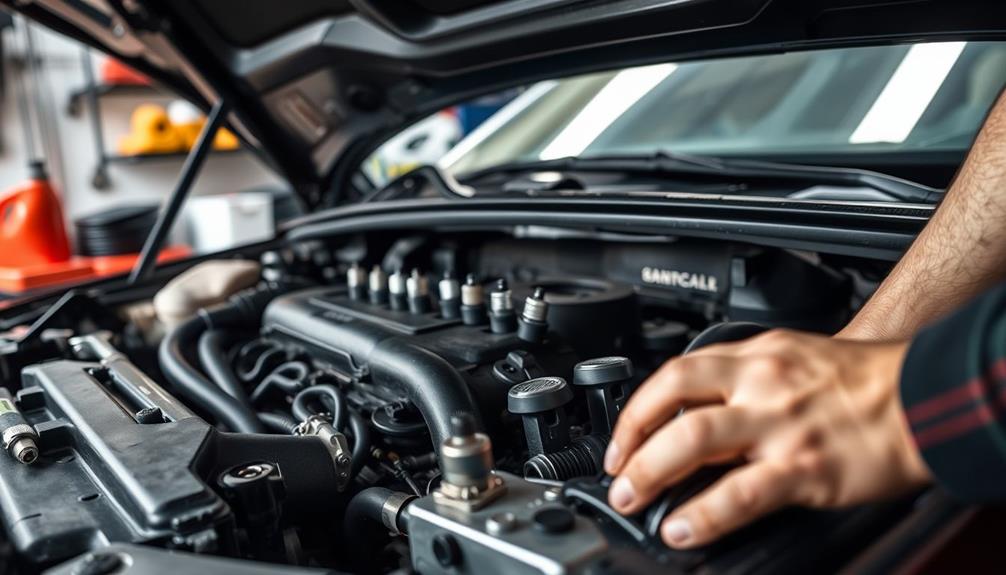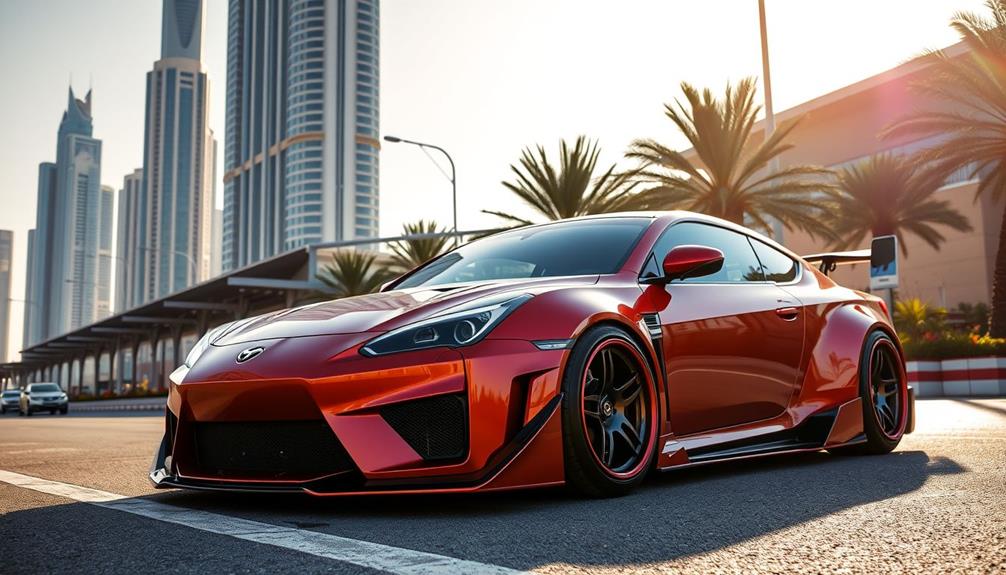Car tuning costs can vary widely based on what you're looking to achieve. Basic upgrades typically range from $200 to $400, while more advanced ECU remaps might set you back between $300 and $800. Dyno tuning sessions usually cost between $200 and $1,000, whereas extensive performance modifications can hit $10,000 or more. Factors like your vehicle type, labor costs, and location can also influence prices. Whether you're interested in improving horsepower or fuel efficiency, the right upgrades can make a significant difference. You might find some intriguing options for enhancing your ride's performance.
Key Takeaways
- Basic tune-ups typically cost between $200 and $400, while more extensive performance upgrades can range from $1,000 to $10,000.
- ECU remapping generally falls between $300 and $800, depending on the vehicle and complexity of the tune.
- Dyno tuning sessions usually range from $200 to $1,000, optimizing performance with a dynamometer.
- Labor costs for professional tuning can range from $75 to $150 per hour, influencing the overall price.
- Additional expenses may include tuning devices, which can add $300 to $400 to the total cost.
Types of Car Tuning
When you plunge into car tuning, you'll discover several exciting types that can transform your vehicle's performance and appearance.
Engine tuning is one of the most popular options, focusing on modifications to the ECU and key components like turbochargers and exhaust systems to boost power and efficiency. Depending on the complexity, the cost of tuning for engine modifications can range from $300 to $2,000.
Suspension tuning is another significant area, enhancing your vehicle's handling and stability, especially for those aiming for performance or off-road capabilities. The costs here vary widely based on the upgrades you choose.
Body tuning adds aesthetic value through aerodynamic enhancements and cosmetic changes, such as body kits and spoilers. Prices for body tuning can range from a few hundred dollars to several thousand, depending on the materials and design complexity.
Lastly, dyno tuning optimizes vehicle performance using a dynamometer to adjust fuel maps and ignition timing, typically costing between $200 and $1,000 for a full session.
With various stage tuning options available, from basic ECU remaps to extensive performance upgrades, you can easily find a tuning path that suits your budget and goals.
Reasons for Car Tuning

Car tuning offers a range of compelling benefits that can make your driving experience more thrilling and efficient. One of the main reasons to contemplate car tuning is the potential to improve power; many enthusiasts experience a horsepower increase of 10-30%. This boost can greatly enhance your vehicle's performance and acceleration.
Additionally, optimized tuning settings can help improve fuel efficiency, allowing you to get more miles per gallon and reduce long-term fuel costs. By adjusting the ECU, you can tailor your vehicle's performance to match your driving style and preferences.
There are various types of tuning available, each catering to different needs, whether you want simple performance upgrades or more advanced modifications. Moreover, well-tuned cars often attract more buyers, enhancing their resale value compared to standard models.
Ultimately, car tuning not only makes your vehicle more enjoyable to operate by improving throttle response but also personalizes it to fit your unique driving experience.
Cost Breakdown of Tuning

Tuning your vehicle can come with a range of costs that vary based on the type and complexity of the upgrades you choose. Here's a breakdown of what you can expect:
- Basic Tune-Ups: Typically cost between $200 and $400.
- ECU Remapping: Generally falls between $300 and $800.
- Dyno Tuning: Sessions can range from $200 to $1,000.
- Performance Upgrades: More complex enhancements, like adding a turbocharger or modifying the exhaust system, can cost anywhere from $1,000 to $10,000.
If you're looking to improve fuel economy, remote tuning options might be the way to go, often dropping below $400.
Keep in mind that while basic car tuning can be relatively affordable, significant upgrades can lead to unexpected expenses. For example, installing a new exhaust system or upgrading the engine can significantly increase the car tuning cost. Additionally, more power and performance often require maintenance and repairs at a higher frequency, adding to the overall cost of tuning. It’s important to carefully consider the potential long-term expenses before committing to major upgrades.
Whether you opt for performance upgrades or cosmetic changes like body kits, it's crucial to understand the costs involved.
Ultimately, the type of tuning you choose will dictate your budget. Always plan accordingly to guarantee your car tuning experience is satisfying without breaking the bank.
DIY Tuning Options

For those looking to save money and take control of their vehicle's performance, DIY tuning options can be a great route. You can start with simple tasks like changing spark plugs and replacing your air filter, which often costs around $19.95.
These basic upgrades can enhance your car's efficiency and even lead to better fuel economy. If you're feeling adventurous, consider installing a cold air intake or modifying your exhaust system to boost performance further.
Another option is updating your engine control unit (ECU) software. Many modern vehicles allow for updates through USB or over-the-air (OTA) methods, letting you skip dealership fees.
If you're interested in handling improvements, lowering springs can be an affordable upgrade starting at around $350.
While some DIY tuning options are straightforward, always research and prepare for your projects. Understanding the costs and benefits is essential to guarantee your modifications achieve the desired performance upgrades.
Just remember, for more complex tasks, you might still need professional assistance, especially when it comes to extensive tuning software or significant engine adjustments.
Factors Influencing Tuning Prices

When considering how much tuning might cost, it's essential to recognize that various factors can greatly influence the final price. Here are some key elements that you should keep in mind:
- Type of Vehicle: The make and model considerably affect tuning complexity. Custom tunes generally require more expertise, leading to higher costs.
- Labor Costs: Professional tuning labor costs can range from $75 to $150 per hour, depending on the modifications needed.
- Geographic Location: Prices for tuning services vary widely based on your area. Local demand and shop reputation can lead to costs ranging from $200 to $900 for standard tuning services.
- Additional Charges: Don't forget potential extra fees, like tuning devices. Handheld tuners can add $300 to $400 to your overall expense.
The complexity of the tuning process also plays a major role. Adjustments to the engine control unit (ECU), including fuel maps and ignition timing, often necessitate professional intervention, which compounds the overall price.
Benefits of Car Tuning

Releasing your vehicle's full potential through car tuning can lead to a remarkable transformation in performance and efficiency. By optimizing your engine control unit (ECU), you can boost horsepower by 10-30%, greatly enhancing acceleration and overall performance. These performance upgrades not only elevate your driving experience but also provide a more engaging ride with quicker throttle response.
Moreover, tuning can improve fuel efficiency, potentially increasing your miles per gallon (MPG) by adjusting engine settings to better match your driving style. This means you can enjoy a high-performance vehicle without sacrificing fuel economy.
Another noteworthy benefit is the impact on resale value. Well-tuned vehicles often attract more buyers, leading to a higher resale price compared to their stock counterparts.
| Benefit | Description | Impact |
|---|---|---|
| Increased Horsepower | Boosts acceleration and overall performance | 10-30% increase |
| Improved Fuel Efficiency | Modifies engine settings for better MPG | Potential MPG increase |
| Tailored Driving Experience | Customizes performance to fit your style | Enhanced engagement |
| Higher Resale Value | Attracts more buyers, leading to better prices | Greater market appeal |
| Enhanced Throttle Response | Quicker acceleration for a sportier feel | More responsive driving |
Frequently Asked Questions
How Much Does It Cost to Fully Tune a Car?
When you consider fully tuning your car, expect costs to vary widely. Basic tunes might start around $200, while extensive upgrades can soar to $10,000, depending on what modifications you choose to make.
Are Performance Tunes Worth It?
Performance tunes can transform your ride into a roaring beast on the road. They're definitely worth it for the enhanced power, improved fuel efficiency, and potential resale value, but keep an eye on the risks involved.
How Much Does a Performance ECU Cost?
A performance ECU typically costs between $300 and $800, depending on your vehicle and complexity. Custom tunes can go higher, sometimes reaching $2,000. Consider remote tuning options for a more budget-friendly choice.
Does Tuning a Car Increase Its Value?
Tuning your car can definitely boost its value. Enhanced performance and unique features attract buyers, making your vehicle stand out. Plus, well-documented modifications show you've cared for it, further increasing its appeal in the market.
Conclusion
Just like a musician fine-tunes their instrument for the perfect melody, tuning your car can transform it into a symphony of power and performance. While the costs may vary, investing in the right upgrades can create a ride that feels like a well-composed masterpiece. Remember, each modification is a note in your vehicle's performance song, leading to a thrilling experience on the road. So, embrace the journey of tuning, and let your car sing its true potential.










